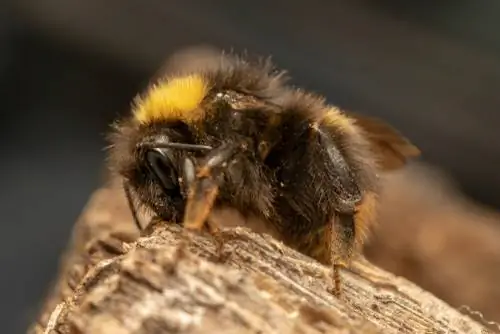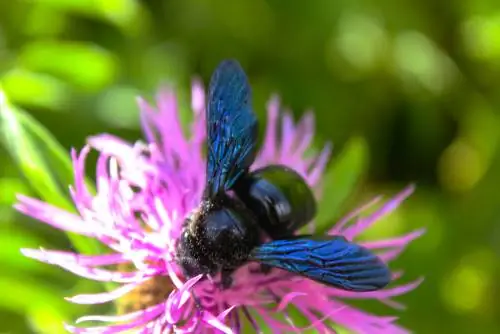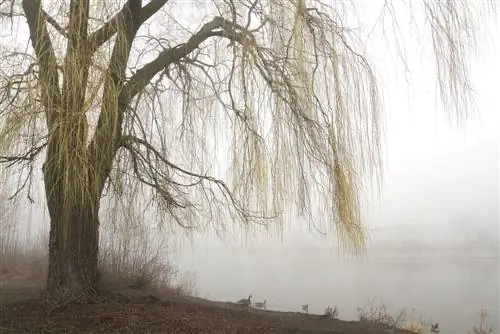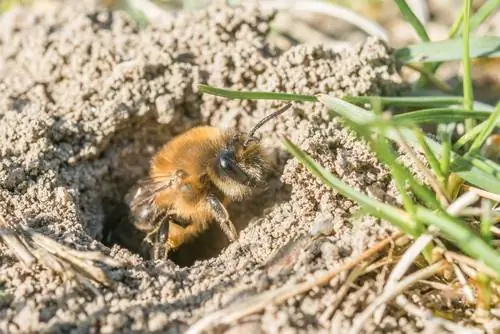- Author admin [email protected].
- Public 2023-12-26 14:17.
- Last modified 2025-06-01 06:02.
From the end of February onwards, the first bumblebees are out and about in the garden looking for food. The wild bee - because that is what it is - is a valuable helper in the garden and pollinates numerous flowers and crops.
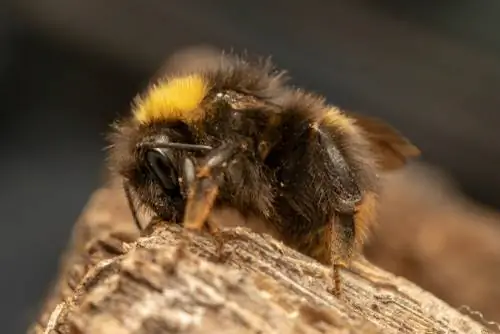
What are earth bumblebees?
Bumblebees belong to the genus of bumblebees (lat. Bombus), which in turn are assigned to real bees (lat. Apidae). Like these, they are colony-forming insects that consist of a queen, the bumblebee colony, which consists of around 50 to 600 workers, depending on the species, and the male drones. There are 36 different bumblebee species in Germany, 16 of which are already on the list of endangered species.
An estimated 250 different species are known worldwide, most of which occur in the temperate regions of the Earth's northern hemisphere. Where it is warmer, the occurrence is limited to the cooler mountain areas. In addition to the colony-forming species, there are so-called cuckoo bumblebees, which are, however, parasites. These - like the bird that gives them their name - lay their eggs in the nests of foreign bumblebee species and displace them.
Species
The dark bumblebee (lat. Bombus terrestris) is one of the most common and largest bumblebee species. The generalist occurs in almost all landscapes in Germany and can also often be seen in gardens. In addition, due to its great importance in plant pollination, this species is bred and used in agriculture almost all over the world. However, there are also other species that are particularly important for gardening and that we would like to introduce to you here.
| German name | Latin species name | Occurrences | habitat | Characteristic features | Queen Size | Worker Size |
|---|---|---|---|---|---|---|
| Dark Earth Bumblebee | Bombus terrestris | originally Europe, North Africa, Asia Minor | Forests, meadows, fields, gardens both in the lowlands and in the mountains | black base color, two yellow cross bands, white abdomen | 20 to 30 millimeters | 9 to 10 millimeters |
| Great Earth Bumblebee | Bombus magnus | Central Europe | especially in lowlands: heath, grassland, fallow land, meadows, embankments. Fields, gardens | black basic color, two yellow cross bands, white abdomen, distinguishing feature: front band extends beyond the base of the wings | 19 to 22 millimeters | 11 to 17 millimeters |
| Light yellow earth bumblebee | Bombus lucorum | mainly Europe | open areas in lowlands and mountains | black base color, first horizontal stripe light to lemon yellow, second horizontal stripe darker, white abdomen | 18 to 21 millimeters | 9 to 15 millimeters |
However, the species of bumblebees mentioned here are very similar in terms of their lifestyle and other characteristics.
Endangered Bumblebees
For many reasons, the population of ground bumblebees and other bumblebee species is at great risk. In addition to natural enemies such as hungry birds, hedgehogs or shrews, weather conditions and the availability of food available all year round also play a major role in population development. Industrial agriculture not only destroys valuable habitats for bumblebees, but also causes bumblebees to die in the wild through the use of toxic sprays such as various insecticides.
Do not remove bumblebee nest
It is all the more important to protect bumblebees in the garden and not to remove nests, for example. Don't be afraid of the animals: they won't harm you, but will instead diligently visit your plants. In any case, the removal of bumblebee nests is prohibited by law because they are highly threatened and protected species. Only in absolutely exceptional cases - for example if the nest is in the house and you are proven to be allergic - are professionals allowed to remove it.
Discovered today while cleaning up old boards?? I've never seen a bumblebee's nest so close. Of course I carefully placed Dad Brett over it again so as not to disturb the animals any further. Simply beautiful ❤ bumblebee earthhummel nest discovered funddestages nature beautiful smallhelpers garden pollinate important nectar food insects ilovemygarden picoftheday instaday stunning happy
A post shared by Meike F. (@missfees) on Jul 23, 2019 at 3:51am PDT
Can bumblebees sting?
Basically, all species of bumblebees are rather peaceful animals that rarely sting. Only female bumblebees have a stinging apparatus, while drones remain stingless. Unlike bees or wasps, bumblebees threaten even before they sting their would-be attacker. They first lift one leg - which people often interpret as “waving” - before finally humming noticeably loudly and turning onto their back. The bumblebee stretches its abdomen forward ready to attack - and you should make sure you get away very quickly.
Even if you aren't quick enough and get stung, it's not a problem: Bumblebees release less poison when they sting than bees, and their stinger doesn't have a barb and therefore doesn't get stuck in the skin. As a result, the sting of a bumblebee is less painful than that of a bee. The following symptoms are characteristic of a bumblebee sting:
- Redness of the skin
- Swelling of the sting site
- Formation of a white yard
- Wound burns at first
- Itching starts later
Overall, the symptoms mentioned are less severe than those of a bee or wasp sting and should subside after about a week.
Proper behavior
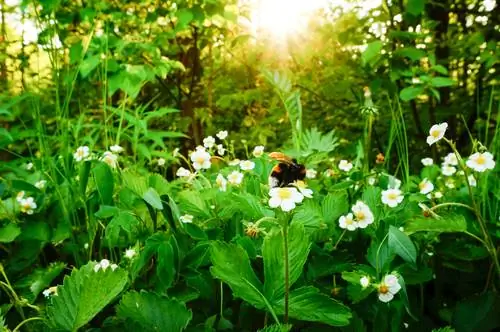
Ground bumblebees are not aggressive and are usually not a danger to humans at all
Don't be afraid if a bumblebee comes near you: As a rule, the insect just mistakes you for a flower, for example because you are wearing sweet-smelling perfume or colored clothing. In this case, stay calm, move slowly and under no circumstances hit the animal - the insect will quickly realize its mistake and continue flying. The peaceful bumblebees only sting when they feel threatened by, for example, hectic movements.
Useful helpers in the garden
Don't be alarmed if you discover a bumblebee's nest in the garden - and under no circumstances try to remove it. The buzzing flying miracles are extremely useful animals that are responsible for the pollination of numerous garden plants such as tomatoes, cucumbers, zucchini and pumpkin. Bumblebees can pollinate many more flowers than bees because their proboscis is longer, making it easier for them to reach them.
In addition, it is thanks to their dense fur - in which the flower pollen gets stuck - that the pollen is distributed more evenly on the stigmas - and the fruits later grow more evenly and symmetrically. A beautifully grown tomato or strawberry is usually the result of bumblebee pollination. Bumblebees are the first fliers of the year and are therefore essential for pollinating early-flowering fruit trees - such as cherries, apricots or peaches.
Bumblebees fly even in the cold
In contrast to honey bees and other bee species, bumblebees fly very early in the year - and even when it is still far too cold for other pollinating insects. The wintering queen of the dark bumblebee can be found outdoors at temperatures of around two degrees Celsius, while the honey bee only flies at temperatures of around 12 to 15 degrees Celsius. This is made possible by the thick hair that reliably protects the “bees in fur” from the cold.
For this reason, some bumblebee species even occur at altitudes of up to 6,000 meters and ensure pollination of the alpine flora - these are heights at which a honey bee does not even dare to go. Bumblebees are also incredibly hard-working: The lively fellows fly back and forth for up to 18 hours a day, covering many kilometers. They pollinate many thousands of flowers. In this respect, it's not just the bumblebees that outdo their close honey-collecting relatives.
Excursus
Bumblebees in agriculture
So it's no wonder that the dark bumblebee in particular is specially bred and used in agriculture. Entire colonies find a new habitat in various greenhouse crops, for example for strawberries or tomatoes, where they are used to pollinate fruit and vegetables - which we can then later buy in the supermarket. The following video shows exactly how this works:

Appearance
The fat bumblebees have black hair and are easy to recognize by their two yellow bands. Depending on the species, these are colored differently. The dark bumblebee, for example, has dark yellow crossbars, the light yellow one has slightly lighter ones. However, you have to look very closely to notice the difference. The last two abdominal segments are colored white in all species. Compared to other bumblebee species, earth bumblebees have slightly shorter proboscises, which, for example, only cover about half the length of the body of the dark earth bumblebee.
By the way, this species is the largest bumblebee species in Germany, whose queens can be up to 30 millimeters long. The state's other bumblebees only reach half this length and reach a maximum length of 17 millimeters.
Excursus
This is why bumblebees can fly
For a long time, scientists puzzled over why the fat bumblebees, which are rather heavy compared to other insects, can fly at all. After all, their wings are too short in relation to their large, heavy bodies - so how do the animals stay in the air? Scientists only discovered the secret around 50 years ago: the bumblebee's extremely mobile wings beat up to 200 times per second, creating air vortices - which ultimately provide the animal with the necessary lift. Bumblebees are not as sedate as they appear at first glance, but are true flight artists.
Habitat and distribution
The dark and light yellow bumblebees in particular are (still) quite common in Europe, where they prefer to live in open landscapes and sparse forests. The animals also like to nest in a bumblebee-friendly garden because they find plenty of food here - in the wild this is becoming increasingly difficult due to industrial agriculture, monocultures and the use of toxic insecticides.
The dark bumblebee builds particularly large nests, and its colonies can contain up to 600 individuals. As their name suggests, earth bumblebees like to build their nests underground and prefer to use abandoned mouse nests, but also other opportunities such as cavities in appropriately constructed dry stone walls, piles of stones or similar.
Lifecycle
Ground bumblebees, which are already buzzing around at single-digit temperatures from the end of February / beginning of March, are always young queens from last year. These have overwintered underground and are now looking for food - the supplies have long since been used up. The animals also need a lot of energy to build a nest and found a new bumblebee colony, because, unlike honey bees, only the queens overwinter. These were already mated by the drones the previous year and begin laying eggs after building the nest. From these, first the workers emerge, later the drones and, at the very end, the new young queens. These in turn overwinter alone, while the old queen and her state die at the end of the summer.
A bumblebee state emerges

The young queens that awaken in late winter fly out as soon as the first spring rays of sunshine warm the ground. They look for food and potential nesting places, which they find primarily in
- mouseholes
- Stone columns
- Drystone walls
- Deadwood pile
- or special nesting boxes
find. Once such an opportunity is found, the bumblebee creates material to build a nest, such as grass, moss or leaves. She crushes this and uses her saliva to form a small hollow ball. In this, the queen first creates wax cells filled with nectar or pollen, which serve as food. The brood cells are then built, in which the first fertilized eggs are laid. Here the bumblebee shows itself to be a true hen because it warms and protects the clutch until the first larvae hatch.
These feed on the previously created food reserves, pupate and transform into finished workers within about three weeks. These now take over the foraging and brood care, as the queen is now only responsible for laying eggs. In this way, the bumblebee population increases very quickly to up to 400 to 600 animals, provided the weather is favorable.
Towards the end of summer, male drones develop from unfertilized eggs, while new queens hatch from some fertilized eggs thanks to a special diet. These mate with the drones, fill their storage containers called honey bladders with food and go to their winter quarters. This is often found in tree roots, cracks in walls or in piles of leaves, where the animals eventually become paralyzed by cold. However, the rest of the bumblebee colony including the old queen dies.
Background
Dangers in winter
However, the dangers of winter are problematic and one of the reasons for the death of bumblebees. An estimated 80 percent of young bumblebee queens do not survive the cold season, but instead fall victim to parasites or hungry animals such as hedgehogs, shrews or moles. This makes it all the more important that you as a gardener offer safe accommodation for wintering.
Protecting bumblebees in the garden
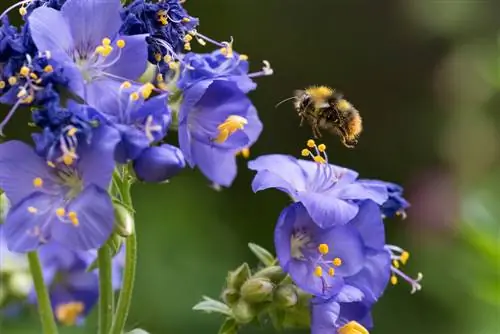
When the garden blooms all year round, there is never a lack of bees and bumblebees
There are many ways to create a comfortable living area for bumblebees in your own garden and thus contribute significantly to the protection of these animals, which are so important to all of us.
What plants should you grow?
The simplest method of bumblebee protection is to grow bumblebee-friendly plants. In principle, bumblebees are not particularly picky when it comes to their food plants - but they still have favorite plants that are usually characterized by a particularly high nectar and pollen content. Also make sure that your garden blooms all year round so that the hungry creatures can always find food. Unlike bees, bumblebees do not store supplies and therefore rely on a richly laid table.
Suitable forage plants at a glance
| Important early bloomers | Nectar-rich summer and long-term bloomers | Nectar-rich trees |
|---|---|---|
| Crocus, stemless cowslip, garden columbine, spotted lungwort, grape hyacinth, winter aconite, squill | Red and white clover, horn trefoil, viper's head, knapweed, cornflower, dandelion, mallow, ground gunder, dost, tomatoes, strawberries, clematis | Black elderberry, dog rose and other wild roses, fruit trees, raspberries, hawthorn, pine tree, blackberry, currant, gooseberry |
Ecological garden care
So that the bumblebees feel comfortable in your garden, it should have some options for building nests. To do this, simply install a bumblebee box, which is usually very popular, leave piles of stones and dead wood in suitable places and perhaps build a dry stone wall planted with long-blooming flowers with larger gaps between the stones. However, the management of the garden is much more important than suitable nesting opportunities: Avoid chemical sprays, especially insecticides, pesticides and other poisons. These not only kill the bumblebees, but also numerous other useful garden inhabitants.
Feeding bumblebees
Due to their size alone, bumblebees have enormous energy requirements. Especially shortly after hibernation, when the food reserves have been used up and the bumblebee cannot find enough flowering plants, it is often too weak and is in danger of dying of hunger. If a bumblebee is crawling on the ground or other surface and moves slowly and doesn't fly away, you can offer a sugar solution to strengthen it and save it.
And this is how you feed the bumblebee:
- Mix half a teaspoon of sugar with a little water.
- Use cold water.
- Stir the mixture vigorously until the sugar is completely dissolved.
- Ladle some sugar solution onto a teaspoon.
- Hold this one out to the bumblebee.
- Stay calm and try not to shake.
- Alternatively, draw some sugar solution into a syringe (without a needle).
- Drop some of the solution directly next to the weakened animal.
Frequently asked questions
Is it true that you shouldn't feed bumblebees?
Some experts are critical of feeding weakened bumblebees and argue that this also causes sick animals to multiply. Diseases and parasite infestations would spread and ultimately cause more harm than good. The fact is, however, that bumblebees are an endangered and protected species - and by feeding them you are not just saving a single bumblebee, but - especially in late winter / spring - an entire bumblebee colony. In addition, the animals are not only weakened by diseases or parasites, but often simply due to a lack of suitable feed plants.
Are there flowers that the bumblebee doesn't like to fly to?
In general, all types of flowers with double flowers are not suitable as food plants for bumblebees and other insects. Many hybrid varieties have beautiful flowers, but no nectar orthe bumblebee cannot reach it. It is therefore better to cultivate species with simple flowers. Silver linden trees and wisteria are also not suitable for bumblebees. The problem with both species, however, is that they attract many of the animals - and then they practically starve in front of the table. Numerous dead bumblebees under the corresponding plants bear witness to this every year.
Can you build a bumblebee box yourself?
The variant with the flower pot turned upside down and with the drainage hole buried in the ground is very old and is often still advertised in gardening magazines. Unfortunately, this method is completely unsuitable as a bumblebee nest because the flower pot offers no protection from rain - the moisture penetrates into the nest through the hole and practically makes it moldy - and the bumblebees cannot crawl in through an entrance on the side. However, the following solution (in English) is much more elegant:

Normal bumblebee nests, especially those located above ground, for which NABU has published building instructions on its website, are not accepted by earth bumblebees.
Tip
You can also grow suitable food plants for the bumblebee on the balcony and thus effectively contribute to bumblebee protection. In particular, summer flowers such as nasturtiums, stonecrops, marigolds, strawflowers and cosmea, flowering herbs such as sage (e.g. mealysage) and chives as well as balcony raspberries and balcony tomatoes attract many of the animals as well as other bees and butterflies.

